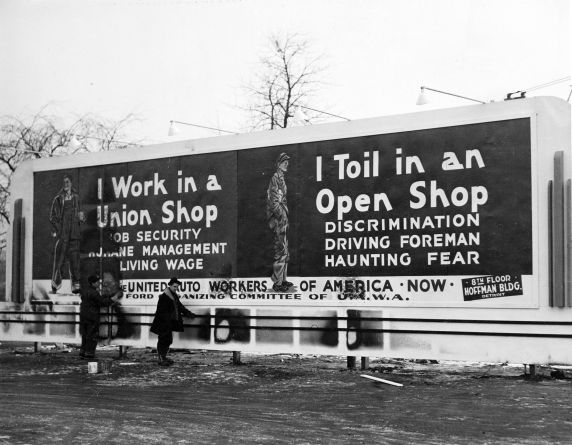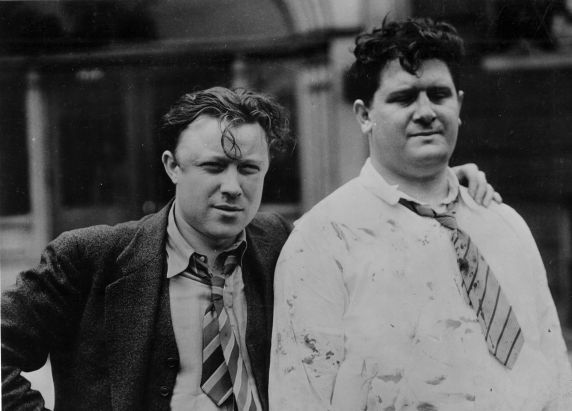
Photographs of Walter Reuther and Richard Frankensteen being beaten by Ford Motor Co. goons during the Battle of the Overpass in 1937 captured a moment in labor history that defined union-management relations at the automaker during the Depression.
A Detroit News photographer was in the right place to take photos of the bloody labor leaders, and the pictures went viral, making Reuther the poster boy for the UAW and set in motion a series of events that led to Ford recognizing the UAW by 1941.

The battle overshadowed a bloodier scene at the Ford Rouge Plant on March 7, 1932 when five participants in the Ford Hunger March were gunned down and died, the shots fired by Harry Bennett’s goons and Dearborn Police.
Those events seem like ancient history, but the issues behind them still resonate as the UAW attempts to persuade southern auto workers to organize, and as Michigan has become a right-to-work state.
These days, few people remember the bloody battles the UAW fought to receive recognition, but that wasn’t true in the 1950s and 60s when I grew up on Detroit’s west side. Like many other Detroit families, mine had a love-hate relationship with the automakers. I heard talk from family members and friends’ fathers, many of them with missing fingers thanks to Mr. Ford’s punch presses, about the feared Bennett, who ran the blandly-named Service Department, and the bloody battle that turned Reuther into a folk hero. Stories were told about Bennett’s men spying on workers to see how long they spent in the bathroom.
I didn’t hear about the hunger march until several years ago when researching a travel guide about Detroit. It was probably because my father revered Henry Ford, who had been a farmer like him, and you couldn’t say anything bad about the old man. My father was a southern Democrat from Arkansas and my mother a classic northern liberal mother, which meant the Civil War continued to rage in our house long after Robert E. Lee surrendered at Appomattox Courthouse.
My parents did agree on Bennett. My father was working at the Ford Rouge Plant when the Battle of the Overpass occurred, and I wish I could claim he was a valiant UAW warrior, but he wasn’t. He was a confused, conflicted southern kid in a strange northern land who was frightened of Bennett, but also distrustful of unions. He was loyal to Henry Ford, who scooped him out of sharecropping poverty with a program that brought agricultural students from across the nation to Detroit for the summer to teach farming at the Henry Ford Trade Schools. That allowed my father to attend college.
White southerners perplex northern liberals and unions because they are savagely independent, arbitrary people who sound like raving socialists one moment and right wing conservatives the next. In the 1960s my mother got involved in the move to start the Detroit Federation of Teachers. My father simmered. That’s the mindset faced by the UAW in the south.
I wished I had the chance to tell my father about the five men who died in the Ford Hunger March and get his southern reaction, but he’s long gone. Because of my parents, I’m bi-cultural and I feel just as at home with a bunch of Arkansas relatives jabbering “Ya’ll” to each other as I am with uptight northern liberals who have little sense of humor.
My father knew the Bennett story well. A shadowy man who hired thugs, ex-prize fighters and former gangsters for plant security and was hated so much he spent his time in homes on the Huron River and in northern Michigan, all with moats, and near water where a boat waited so he could make a quick escape. I visited him home near Clare once when it was a Boy Scout camp and the moat and escape tunnel were still there.
But what my father didn’t know was that in 1932 there were about 400,000 unemployed men in Detroit with no unemployment benefits who were desperate for food. Many of them had migrated to Detroit from other parts of the country and from foreign nations, and often had no relatives to help. Things were different in the south. My grandfather had been laid off from his railroad job, but he had access to farm land and fell back on sharecropping. There were also many relatives to rely on. Some of that’s still true in the south, which makes workers more self-reliant.
I would have told him about the Dearborn Police in wait as 3,000-5,000 unemployed workers assembled on the Dearborn City Limits to march to the Rouge Plant and to present their demands. The Dearborn mayor was Clyde Ford, Henry’s cousin, so police protection was assured. And about how the marchers carried signs that read “We Want Bread Not Crumbs” and “Give Us Work.” And how a mile from the plant, Bennett’s men and police let loose with tear gas, icy water from fire hoses and machine guns, killing three and wounding 22.
My old man’s blood would have boiled when he heard the story about how Bennett is reported to have gotten out of his car and fired into the crowd that was fleeing. At this point, a 16-year-old was shot and killed, and later injured marchers were arrested and chained to their hospital beds by authorities.
However, he would have been delighted that Communists took the blame, and police rounded them up in a frenzy that followed. The press coverage focused on the communist menace, and it was more aligned with the interests of Ford Motor Co. than workers. The company claimed Bennett was injured by marchers, but we’ll probably never know the truth.
After that, Reuther helped purge the UAW of Communists, which paved the way for mainstream acceptance of auto and other unions which turned Detroit into a middle class city for workers who could buy houses and send their kids to college. Like thousands of others in Detroit, I benefited and with the help of a UAW job was able to pay my way through Wayne State.
We’ve all been enriched by the sacrifices of those five who were murdered at the Hunger March and who suffered beatings at the hands of Bennett’s goons, and those people should be remembered.
Jeff Counts
Jeff Counts is the author of Detroit & Ann Arbor: A Great Destination and Michigan: An Explorer’s Guide.


17 Responses to "Bloody union battles taught lessons that resonate today"